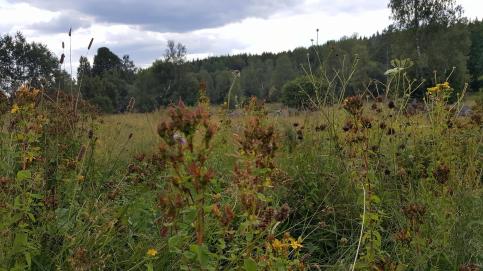Habitat loss in semi-natural grasslands

Habitat loss and fragmentation have shown to have negative effects, such as limiting dispersal and local extinction, on amphibians (Vasconcelos et al. 2016), butterflies (Schtickzelle et al. 2006), birds (Xu et al. 2018) and mammals (van Oort et al. 2011). Smaller and fewer habitat patches create higher pressure on species survival, which can cause local extinctions (Cheptou et al. 2017).
Generalists have an advantage in a fragmented landscape since they can switch food source compared to specialists which only have one or a few preferred food sources (Tscharntke et al. 2002). In small isolated areas the food source can be too small to support their predator even if present. Variation in patch size affects species composition and occurrence of species is dependent by fragment size as well as connectivity between fragments (Tscharntke & Brandl 2004). When patch size decline and distance increase it is the rare sensitive species that disappear first (Golden et al. 1999). This in turn is predicted to influence the species richness of habitat but not necessarily density.
With habitat fragmentation comes an increase in edge effects on habitat. It can change species composition when species not associated with the habitat spill over into the studied habitat (Xu et al. 2018). A study in Germany found that different species composition could be found in semi-natural grasslands depending on adjacent habitat type (Schneider et al. 2016).
Semi-natural grasslands are being fertilized to get a higher yield or they are being converted into arable fields. A study in England estimated this to an 88 % loss of semi-natural grasslands between 1960 to 2013 (Ridding et al. 2015). Grasslands needs maintenance to be kept open and functioning, such as mowing and grazing (Bonari et al. 2017). Abandoning these grasslands have shown to have a negative effect, with a decrease in graze-dependent plants and an increase in trees and shrubs (Öckinger et al. 2006).
Species that respond fast to change are good for studying effects of habitat loss, this because they can indicate how other species will react and what trends that might follow the habitat loss. Beetles are the most diverse animal group and can be tools for assessing freshwater and terrestrial systems (New 2010). Carabids occupy a broad range of habitat and include both specialist and generalist species, they are one of the most well-know groups of beetles in the world.
Carabids vary in size, large insects can have a higher mobility on the ground than smaller species, but better flight capability allows smaller species to still disperse effectively (S˘eric Jelaska et al. 2009). Gutierrez et al. (1997) showed that wing length affects dispersal in carabids, longer wings allows for longer distance flight and higher dispersal. However, long wings can also reduce fitness in areas with inhospitable surrounding (Lindroth 1949, 1953)..
Aim
This study will test how habitat loss and isolation affect carabids by sampling grasslands with different levels of isolation in the municipality of Linköping, Östergötland Sweden. More specifically, to tests if isolation of habitat negatively affects the species diversity. It also tests if there is a relationship between body size and wing length to habitat isolation
Responsible for this page:
Director of undergraduate studies Biology
Last updated:
05/03/18
